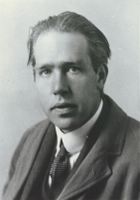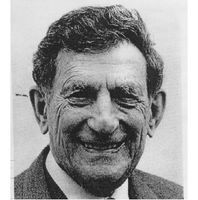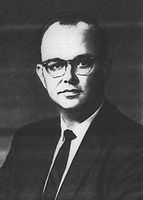We're almost done at this point. I want to sum up the stances of each of the primary schools of thought and then move onto the really interesting piece - the EPR Paradox and Bell's Inequality.
Reality #1 - Copenhagen Interpretation Part A
Stated simply, quons (things like electrons) exist but have no dynamic attributes (position, momentum, etc.) on their own. The conversation could go something like this.
Is the electron in motion? No. Is the electron still? No. Is it here? No. Is it there? No. How fast is it moving? No. What's its energy? No.Note we're not taking a pragmatic stance where we're refusing to speculate on deep reality. Things like position and momentum just do not exist.
 Believers of this interpretation key off the uncertainty principle. Depending on how we measure a quon, we squeeze possibilities on one attribute and allow others in the conjugate attribute. Our choice of what we measure dictates what we'll see. Things like position and momentum for quons are not things inherent to the quon. They are only a particular aspect of the quon that we are extracting from the quon as a whole when we observe it.
Believers of this interpretation key off the uncertainty principle. Depending on how we measure a quon, we squeeze possibilities on one attribute and allow others in the conjugate attribute. Our choice of what we measure dictates what we'll see. Things like position and momentum for quons are not things inherent to the quon. They are only a particular aspect of the quon that we are extracting from the quon as a whole when we observe it.Before I mentioned that the uncertainty does not come from our probing the object and disturbing it. We are not increasing the uncertainty of the momentum when we measure its position by causing some kind of experimental disturbance. The best way to see this is through a Renninger style experiment. Renninger was fascinated by null results. In other words, gathering information by the absence of a detection event. Imagine a photon traveling to 2 mirrors. We don't know which one. We have a detector on one mirror. If the photon is released and we don't detect it on one mirror then we know it must have hit the other. To Renninger's amazement he found that this also collapses the proxy wave and increases the uncertainty in the conjugate variable. Clearly we have not interfered with that photon. Yet our knowledge of the hit by our null result specifies it's location and naturally causes the momentum attribute uncertainty to increase.
Here's a great way to think about what Bohr believed. When we measure an attribute we should not think of the object as having that attribute. The attribute is really a relation between the quon and our measurement device. Think of it this way. You have a recording of traffic noise. You can decompose (like we do in quantum theory when extracting attributes) the sound into multiple waveforms that add up to the traffic noise. Say we use the waveform of a tuba to do this. Does this make the traffic noise a chorus of tubas? No. Bohr thinks of quons the same way. When we extract the momentum waveform from Psi it doesn't mean Psi or the quon have a momentum attribute. The momentum is just something we experience in the classical world. The world we know extracts certain attributes out of the quon like a filter. When we look at something we see it's position. It's possible to imagine a world where we 'see' the energy attribute instead or some other completely arbitrary attribute (there are after all an infinite number of attributes because there are an infinite number of waveforms we can extract from Psi). The quon itself is forever beyond us. We can only extract and observe certain attributes of it.
That's not to say the quon is subjective. It is objective. It's just not an object. It's like a rainbow. Everyone views a different rainbow depending on where they observe it. But we experience it objectively. For example we can take a picture of the rainbow. The rainbow is due to light, rain, and our looking at it from a particular perspective. A quon is the same way. The quon does not have an attribute. It is made up from the quon and us measuring something about it.
I'll end with a Heisenberg quote
The quantum world is not made up of objects. Atoms are not things.Reality #2 - Copenhagen Interpretation Part B
Expanding on the role of the measurement device, Part B emphasizes the observer's special status in the world. Observer created reality is the essence here. Our decision to make a particular measurement of an attribute is what creates our classical reality. When we don't look at the moon, the moon is still there but it's a quantum object. It's only when we look at it do we filter the moon's Psi through our own position filter to see where it is.
Imagine this experiment. Massive entities can bend light. Galaxies are massive enough that they can bend light from a star behind it (actually a quasar in this case) such that the light that goes to the left and the light that goes to the right bends back to meet at a common focal point. From our vantage point it looks like 2 stars. Now if we measure the photons coming towards us with a detector that is located where the photons arrive together (focal point) we will see an interference pattern. This means that the photon went both sides of the galaxy in its probabilistic form. Move the detector back past the focal point and off to the side and you'll get a single point hit (not interference) implying the photon only went around one side of the galaxy. In other words the photon must have gone around to the left of the galaxy for example. How did our moving the detector change where the photon went? In one case it went both sides and in the other case it went only one side. We just changed what happened in the past. Note we don't have control over the past, just that we changed it. Or did we? Is it possible that the photons knew what we are going to do beforehand?
Reality #3 - The Zen Interpretation
 Bohm led this charge. This theory comes from an aspect of quantum theory called phase entanglement. So far we've talked about a single quon. But when two quons interact their phases become entangled. The Psis intermingle and then separate. The amplitudes separate perfectly but the phases are still interacting in what's known as configuration space. It's not a real space but a mathematical space where there are 3 dimensions for each quon involved. In this space you'd see that the Psi is still intermingled.
Bohm led this charge. This theory comes from an aspect of quantum theory called phase entanglement. So far we've talked about a single quon. But when two quons interact their phases become entangled. The Psis intermingle and then separate. The amplitudes separate perfectly but the phases are still interacting in what's known as configuration space. It's not a real space but a mathematical space where there are 3 dimensions for each quon involved. In this space you'd see that the Psi is still intermingled.The quons therefore are essentially described by a single Psi. Collapsing the wave of one quon requires the collapse of the other. This becomes strange when we consider quons that become entangled and then travel billions of miles apart. When we detect the location of one quon, the other quon is located somewhere in space as well as opposed to remaining a probability wave. This creates problems again with the speed of light. This collapse happens instantaneously.
This may not be an issue though because as Heisenberg showed, the wave function may not represent a real situation but rather our knowledge of a situation. If I send two envelopes to you - one with paper inside with the letter A and the other with the letter B, you opening the letter gives you information on what is in the other letter. It's not like letter B suddenly appeared when you know the one you opened was A. But Heisenberg was careful not to say this was the case. In fact when we talk about Bell later we'll see that he will force us to swallow some drastic changes about our concept of reality and the type of long range interactions that may be possible. And in turn lend some credence to this version of reality.
Reality #4 - The Many Worlds Hypothesis
 First dreamed up by Hugh Everett as a PhD student (awesome). Everett hated that measurement devices were in some way special. His goal was to strip away the measurement act. When a quon hits a measurement device the proxy waves for both interact. At this point there is no wave collapse. Rather Everett says that every possible outcome of the attribute being measured comes to fruition. If 5 things could happen then 5 things do happen.
First dreamed up by Hugh Everett as a PhD student (awesome). Everett hated that measurement devices were in some way special. His goal was to strip away the measurement act. When a quon hits a measurement device the proxy waves for both interact. At this point there is no wave collapse. Rather Everett says that every possible outcome of the attribute being measured comes to fruition. If 5 things could happen then 5 things do happen.In order for us to avoid the fact that no one has ever seen multiple outcomes for a single one-time experiment, Everett makes the not so modest proposal that each of these events occurs in parallel universes. These realities split off from the single reality before the interaction. We are only aware of one of these outcomes. Somewhere else the other 4 of us experience the other outcomes in our example.
While this is perhaps the most ludicrous solution, it is the only theory to not place some kind of elevated status on the measurement device. If you find it hard to believe measurement devices are any different than the things they are measuring, this becomes a little easier to swallow than the otherinterpretations.
Next post - the remaining interpretations
Part 1 Part 2 Part 3 Part 4 Part 5 Part 6 Part 7 Part 8 Part 9 Part 10

No comments:
Post a Comment